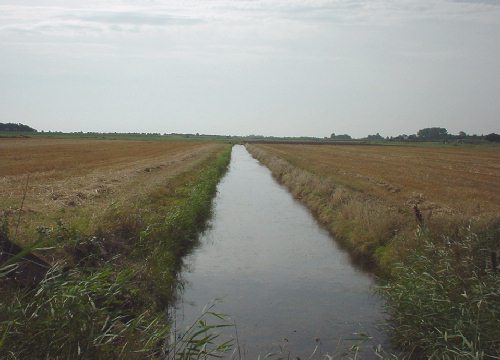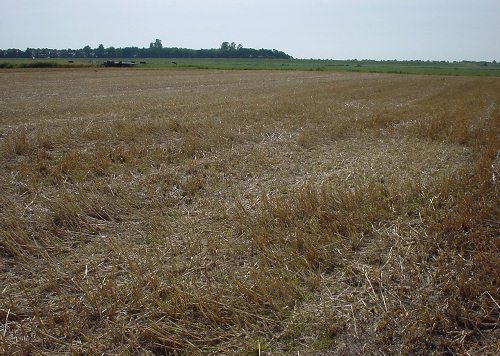Cropcircles on Wieringen, part 2
Found! | The ditch between the two lots at the Julianalaan. |
About a week after the article appeared in the papers my father told he had seen two fields with grain separated by a ditch in the Hippolytushoever koog (the lower lands). "Perhaps that cropcircle is over there" he said jokingly. Only one way to find that out, I thought. So I grabbed my camera and off I went.
The Julianalaan is a narrow countrylane leading from the small woods south of Hippo towards the Wieringermeer. It ends at the Wierdijk where cyclists can cross the canal over a small bridge. It was no more than 2 kilometres from my home. But when I arrived all the grain had gone and even the straw had already been pressed into bales and taken off...
Some traces remain
 | A vague impression of the circle can still be seen. |
In order not to return empty-handed I walked on the field. And indeed, after 150 metres I found the remnants of the circle. There was a clear trace of crushed stalks, in the shape of a circle of 3 metres across. The tail of the figure, the bit of the key, or the mirrored P, was almost completely gone. The photo above doesn't really do justice to the situation, but it wasn't easy to make clear pictures of it. The picture was taken at the end of the "appendix". The next picture also shows the outer ring. In the outer ring the stalks were aligned completely opposite to the stalks in the inner ring. Very original and mysterious.... (not). This ring was made less precise so that less of it could be recovered.

Remaining questions
So now that we have established that the circle was situated near the Julianalaan in the Hippolytushoever koog south of Hippolytushoef (and not in the Polder Waard Nieuwland or Wieringermeer) some unanswered questions remain.
- Why didn't the reporters simply ask the photographer where he had taken the picture? He could have told them immediately they were looking at the wrong place. Silly season I suppose, the newspaper has page to be filled.
- Who made the circle? This is perhaps the most interesting question. Extraterrestrials ought to be capable of better results than this silly circle, so they can be safely discarded. Personally, I think that the persons who discovered the circle also made it. The circle could impossibly be seen from the road. A road that didn't go anywhere and therefore has not much traffic. When the grain is at a height of 50 cm and the circle is 150 metres from the road, it is easy to calculate whether a passing walker was able to see it. I say he/she can't.
In this framework, an anouncement on the Dutch cropcircle site is interesting:
On a page about the cropcircle at "Hypolitushoef" (they never learn to spell...) the following report can be found. Made by the discoverer, with diagrams that look remarkably like designdrawings and with a listed date of discovery August 7 - 10 days before the newspaperarticle was published:
I found the formation at the afternoon of August 7. I suspected something was in that field, because I saw some birds land in there. With a friend I went to take a look and then discovered the formation, we went in it as well. I have discovered and reported cropcircle formation in this area before.
The formation is at the back of the field and can not or hardly be seen from the road. When you enter the formation, first you enter the largest circle. This one has a diameter of approx. 10 metres. At the interior of the circle the stalks lie in a counter-clockwise spiraling way. The remarkable thing about this formation is that at the outer rim of the circle the flattened grain rotates clockwise. From the maincircle a path lies with a length of about 10 metres. This path is not straight, it deviates to the left. At the end of the path it returns in an arch to the maincircle. The formation looks to have been here for a while, in view of the fact that the edges of the formation are very weathered. De edges are therefore very rough.
Conclusion
The intention of this article was to show where this circle was, not immediately who made it. The location has been proven now, and as far as the makers are concerned I have only been able to make some suggestions. The truth will remain unknown until the maker(s) come forward. They may send me an e-mail!
start / Dutch | history | legends | old photos | villages | anthem | links | search
|



